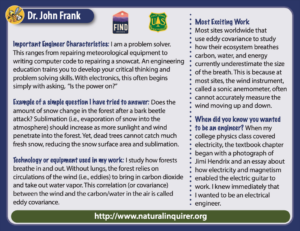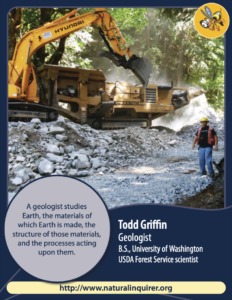Welcome to our website’s resource library, where we offer an extensive collection of free science materials tailored for K-12 students. Dive into a wealth of educational resources including articles, activities, lesson plans, learning modules, and much more. All materials are free to download!
-

 Forests & PlantsWeather & Climate
Forests & PlantsWeather & ClimateJohn Frank, Electronics Engineer

- Ph.D., University of Wyoming
- USDA Forest Service Scientist
- An electronics engineer in the Forest Service usees math, physics and computers to design circuits, write programs, and build instruments to answer questions about how our forests function.
- Ph.D., University of Wyoming
- USDA Forest Service Scientist
- An electronics engineer in the Forest Service usees math, physics and computers to design circuits, write programs, and build instruments to answer questions about how our forests function.
-

 Forests & Plants
Forests & PlantsZhiyong Cai, Material Engineer

- Ph.D., Purdue University
- USDA Forest Service Scientist
- A material engineer develops new and improved composite materials by working with wood and other non-wood fiber sources.
- Ph.D., Purdue University
- USDA Forest Service Scientist
- A material engineer develops new and improved composite materials by working with wood and other non-wood fiber sources.
-

 WaterWildlife
WaterWildlifeLeslie J. Boak, Construction Engineer

- B.S., Oregon State University
- USDA Forest Service Scientist
- A construction engineer is responsible for making sure all of the world’s infrastructures (e.g. the roads you drive on, the buildings that you go to school in, the systems that supply the water you drink) are built safely and correctly.
- B.S., Oregon State University
- USDA Forest Service Scientist
- A construction engineer is responsible for making sure all of the world’s infrastructures (e.g. the roads you drive on, the buildings that you go to school in, the systems that supply the water you drink) are built safely and correctly.
-

 LandformsSoilWater
LandformsSoilWaterMichael Balen – Civil, Mining, & Geological Engineer

- B.S. University of Alaska, Fairbanks
- USDA Forest Service Scientist
- As a Forest Service engineer, I manage the built environment, including the roads, bridges, and facilities, that connect people to the national forest landscape and enable Forest Service employees to do their jobs.
- B.S. University of Alaska, Fairbanks
- USDA Forest Service Scientist
- As a Forest Service engineer, I manage the built environment, including the roads, bridges, and facilities, that connect people to the national forest landscape and enable Forest Service employees to do their jobs.
-


Bruce A. Schumacher, Paleontologist

- Ph.D., South Dakota School of Mines
- USDA Forest Service Scientist
- Paleontology is the study of past life on Earth, from single-celled organisms to vertebrate animals. A paleontologist thinks about the idea of humans on Earth which has geologic layers filled with extinct life forms spanning billions of years.
- Ph.D., South Dakota School of Mines
- USDA Forest Service Scientist
- Paleontology is the study of past life on Earth, from single-celled organisms to vertebrate animals. A paleontologist thinks about the idea of humans on Earth which has geologic layers filled with extinct life forms spanning billions of years.
-

 Forests & PlantsLandforms
Forests & PlantsLandformsJenna Padilla, Geologist

- B.S., University of New Mexico
- USDA Forest Service Scientist
- A geologist for the Forest Service conducts studies and investigations on projects where minerals and geology impact the development or management of the forest resources (e.g., trees, range land, soil, water systems, wildlife). Geologists also manage material projects that are conducted on public lands and mitigate Abandoned Mine Land features.
- B.S., University of New Mexico
- USDA Forest Service Scientist
- A geologist for the Forest Service conducts studies and investigations on projects where minerals and geology impact the development or management of the forest resources (e.g., trees, range land, soil, water systems, wildlife). Geologists also manage material projects that are conducted on public lands and mitigate Abandoned Mine Land features.
-

 Landforms
LandformsJoanna Kovarik, Geologist & Speleologist

- Ph.D., University of South Florida
- USDA Forest Service Scientist
- A speleologist is a scientist who studies caves and the environments in which caves occur. Speleologists come from a diversity of educational backgrounds. My background is hydrogeology and geography.
- Ph.D., University of South Florida
- USDA Forest Service Scientist
- A speleologist is a scientist who studies caves and the environments in which caves occur. Speleologists come from a diversity of educational backgrounds. My background is hydrogeology and geography.
-

 LandformsMapping
LandformsMappingSabry Hanna, Geologist

- Ph.D., Cairo Univeristy (Egypt)
- USDA Forest Service Scientist
- Geology is the study of Earth, the materials of which it is made, the structure of those materials, and the processes acting upon them. An important part of geology is the study of how Earth’s materials, structures, processes and organisms have changed over time.
- Ph.D., Cairo Univeristy (Egypt)
- USDA Forest Service Scientist
- Geology is the study of Earth, the materials of which it is made, the structure of those materials, and the processes acting upon them. An important part of geology is the study of how Earth’s materials, structures, processes and organisms have changed over time.
-

 Landforms
LandformsTodd Griffin, Geologist

- B.S., University of Washington
- USDA Forest Service Scientist
- A geologist studies Earth, the materials Earth is made, the structure of those materials, and the processes acting upon them.
- B.S., University of Washington
- USDA Forest Service Scientist
- A geologist studies Earth, the materials Earth is made, the structure of those materials, and the processes acting upon them.
-

 LandformsWildlife
LandformsWildlifeMichael Fracasso, Paleontologist & Geologist

- Ph.D., Yale University
- USDA Forest Service Scientist
- Paleontologists study fossils, and the rocks in which fossils occur, to understand how ancient organisms lived. This focus enables paleontologists to document and interpret the history of life on Earth.
- Ph.D., Yale University
- USDA Forest Service Scientist
- Paleontologists study fossils, and the rocks in which fossils occur, to understand how ancient organisms lived. This focus enables paleontologists to document and interpret the history of life on Earth.























